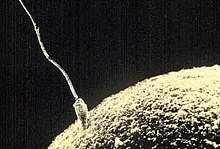Oogamy
This article's lead section may be too short to adequately summarize the key points. (August 2021) |

Oogamy is an extreme form of anisogamy where the gametes differ in both size and form. In oogamy the large female gamete (also known as ovum) is immobile, while the small male gamete (also known as sperm) is mobile.[1] Oogamy is a common form of anisogamy, with almost all animals and land plants being oogamous.
Occurrence[]
Oogamy is found in most species that reproduce sexually, all higher species being oogamous.[2]
Oogamy is found in all land plants,[3] and in some red algae, brown algae and green algae.[4] Oogamy is favored in plants because only one gamete has to travel through harsh environments outside the plant.[5] Oogamy is also present in oomycetes.[6]
Almost all animals are oogamous.[7] There are exceptions, such as the opiliones that have immobile sperm.[8]
Etymology[]
The term oogamy was first used in the year 1888.[9]
Evolution[]
It is generally accepted that isogamy is the ancestral state[10] and that oogamy evolves from isogamy through anisogamy.[11][12] However, transitions do exist between anisogamy and oogamy.[13]
When oogamy has evolved, males and females typically differ in many aspects. According to David B. Dusenbery internal fertilization probably originated from oogamy.[7] But one study in 2014 on Colemanosphaera said that oogamy in Volvox may have evolved before the transition from external to internal fertilization.[14][non-primary source needed]
In streptophytes, oogamy likely first occurred before the split between algae and land plants.[15]
See also[]
References[]
- ^ Fusco, Giuseppe; Minelli, Alessandro (2019-10-10). The Biology of Reproduction. Cambridge University Press. pp. 111–112. ISBN 978-1-108-49985-9. Retrieved 29 March 2021.
{{cite book}}: CS1 maint: url-status (link) - ^ Bell, Graham (2019-11-28). The Masterpiece of Nature: The Evolution and Genetics of Sexuality. Routledge. p. 63. ISBN 978-1-000-49744-1.
- ^ Simpson, Michael G. (2010-07-19). Plant Systematics. Academic Press. p. 58. ISBN 978-0-08-092208-9.
- ^ Raven, Peter H.; Evert, University Ray F.; Evert, Ray F.; Eichhorn, Susan E.; Eichhorn, University Susan E. (2005). Biology of Plants. W. H. Freeman. p. 309. ISBN 978-0-7167-1007-3.
- ^ Raven, Peter H.; Evert, University Ray F.; Evert, Ray F.; Eichhorn, Susan E.; Eichhorn, University Susan E. (2005). Biology of Plants. W. H. Freeman. p. 376. ISBN 978-0-7167-1007-3.
- ^ Buaya, Anthony T.; Thines, Marco (2020). "An overview on the biology and phylogeny of the early-diverging oomycetes". Philippine Journal of Systematic Biology. 14 (1): 1-20. doi:10.26757/pjsb2020a14004.
- ^ a b Dusenbery, David B. (2009). Living at Micro Scale: The Unexpected Physics of Being Small. Harvard University Press. p. 326. ISBN 978-0-674-06021-0.
- ^ Leonard, Janet; Cordoba-Aguilar, Alex (2010-07-19). The Evolution of Primary Sexual Characters in Animals. Oxford University Press, USA. pp. 18–19. ISBN 978-0-19-532555-3.
- ^ "Definition of OOGAMY". www.merriam-webster.com. Retrieved 2021-09-14.
- ^ Pitnick, Scott S.; Hosken, Dave J.; Birkhead, Tim R. (2008-11-21). Sperm Biology: An Evolutionary Perspective. Academic Press. pp. 43–44. ISBN 978-0-08-091987-4.
- ^ Kumar, Awasthi & Ashok. Textbook of Algae. Vikas Publishing House. p. 363. ISBN 978-93-259-9022-7.
- ^ Dusenbery, David B.; Dusenbery, Professor of Biology Emeritus David B. (2009). Living at Micro Scale: The Unexpected Physics of Being Small. Harvard University Press. p. 309. ISBN 978-0-674-03116-6.
- ^ Hörandl, Elvira; Hadacek, Franz (August 2020). "Oxygen, life forms, and the evolution of sexes in multicellular eukaryotes". Heredity. 125 (1): 1–14. doi:10.1038/s41437-020-0317-9. ISSN 1365-2540. PMC 7413252. PMID 32415185.
- ^ Nozaki, Hisayoshi; Yamada, Toshihiro K.; Takahashi, Fumio; Matsuzaki, Ryo; Nakada, Takashi (2014-03-03). "New "missing link" genus of the colonial volvocine green algae gives insights into the evolution of oogamy". BMC Evolutionary Biology. 14 (1): 37. doi:10.1186/1471-2148-14-37. ISSN 1471-2148. PMC 4015742. PMID 24589311.
- ^ Geng, Sa; De Hoff, Peter; Umen, James G. (2014-07-08). "Evolution of Sexes from an Ancestral Mating-Type Specification Pathway". PLOS Biology. 12 (7): e1001904. doi:10.1371/journal.pbio.1001904. ISSN 1544-9173. PMC 4086717. PMID 25003332.
- Reproductive system
- Germ cells
